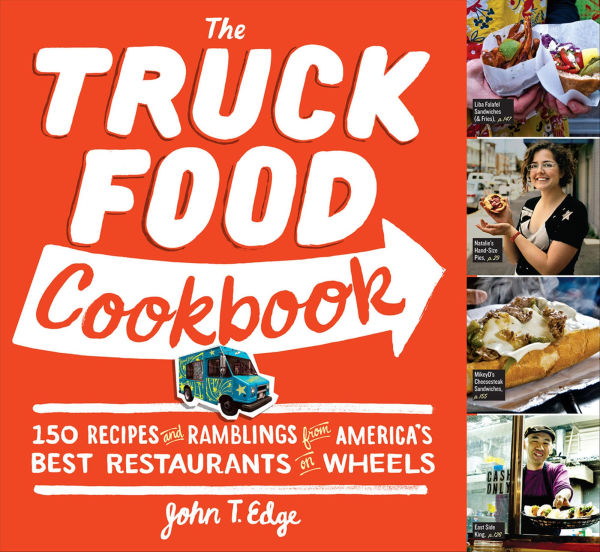Read an Excerpt
CHAPTER 1
FRIES & PIES
MENU POTATO CHAMPION FRIES with Tarragon & Anchovy Mayonnaise
PORTLAND POUTINE
SWEET POTATO FRIES with Cilantro, Garlic, and Lime
FRIED YUCCA with Garlic-Cilantro Sauce
CHICKPEA FRIES
TATER TOTS with Sumac
HAM CROQUETAS
MOLOTES OAXAQUENOS
EMPANADAS DE HUITLACOCHE
CHICKEN CHEDDAR BACON PASTIES
SWEET POTATO AND SWISS CHARD PIES
JAMAICAN MEAT PATTIES
SALMON AND CHIPOTLE FRIED PIE with Chipotle Mayonnaise
CRAWFISH PIES with Creole Cream Cheese
The pairing of fries and pies appears, at first glance, to serve no cause but rhyme. Truth is, in the American South, where I was born and raised, those words get combined often. We have long fried pies in cast-iron skillets roiling with lard. A quick dip in burbling fat bestows texture. Witness the empanada. Behold the french fry. What's more, that quick dip cooks a pie — or a potato or almost anything else — more quickly than does baking or roasting. And, lest you think we're sedentary folk, always reclining on the veranda or some such, we have long tucked those pies in brown paper bags and hit the road or hit the street.
That quick transformation is what street food cooks prize. Long cook times are the bane of vendors the world over, from Hanoi, Vietnam, where curb vendors sell vermicelli-threaded cha gio, to Tucson, Arizona, where Tohono O'odham tribe members fry bread in pots of boiling oil and top them with beans and meats to fashion Native American tacos. In the recipes that follow, if you keep the grease hot and the portion size small, you can be in and out of the kitchen, stall, cart, or truck in the time it takes to refuel the propane tank.
POTATO CHAMPION FRIES
POTATO CHAMPION'S DOUBLE-FRY TECHNIQUE, which I interpret here, yields potatoes that are cottony on the inside and crisp on the out. Texture, as any good fry obsessive knows, is as important as taste. If you want to dunk your fries in the Tarragon and Anchovy Mayonnaise, keep in mind the mayonnaise needs to sit for at least one hour before using.
SERVES 4 TO 6
2 pounds large russet potatoes, peeled Peanut or canola oil Kosher salt Tarragon and Anchovy Mayonnaise (optional, recipe follows), for serving
1 Cut the potatoes lengthwise into ½ inch–thick slices. Stack 2 to 3 slices on top of each other and cut them lengthwise into ½ inch–wide strips. Place the sliced potatoes in a large bowl of cold water for 10 minutes to remove the starch. Drain the potatoes and pat them dry with paper towels.
2 Line a rimmed baking sheet with parchment paper. Add enough oil to a large heavy pot to reach a depth of 4 inches. Attach a deep fry thermometer to the side of the pot and heat the oil over medium-high heat until the thermometer registers 325°F. Working in batches and being careful not to overcrowd the pot, carefully add the potatoes to the hot oil and cook them until tender, 4 to 5 minutes per batch, stirring them occasionally with a slotted spoon. Using the slotted spoon, transfer the potatoes to the parchment-lined baking sheet and let cool for 30 minutes. Do not discard the oil.
3 When ready to serve, reheat the reserved oil over high heat to 375°F. Working in batches, return the potatoes to the hot oil and cook them until golden and crisp, stirring occasionally, 4 to 5 minutes. With the slotted spoon, transfer the fries to paper towels to drain. Sprinkle the fries with coarse salt and serve immediately with the Tarragon and Anchovy Mayonnaise, if desired.
Tarragon and Anchovy Mayonnaise
I DON'T LIKE THE SACCHARINE sweetness of ketchup. Not on my burgers. More important, not on my fries. Which is why I like this stuff so much. In Belgium, where fries may have originated, friteries serve a wide range of sauces, many of which are mayonnaise based. This recipe from Potato Champion relies on mayo as a mere binder for more pungent flavors.
MAKES ABOUT 1 CUP
1 cup mayonnaise
2 tablespoons coarsely chopped fresh tarragon
2 tablespoons coarsely chopped fresh dill
2 anchovy fillets, coarsely chopped
Combine the mayonnaise, tarragon, dill, and anchovies in a food processor or blender and pulse until the herbs are finely chopped. Transfer the mayonnaise to a bowl, cover, and refrigerate for at least 1 hour. The mayonnaise can be refrigerated, covered, for up to 2 days.
PORTLAND POUTINE
THE QUEBECOIS ARE CRAZY for this stuff. So are their snowbird kin down in Florida. Think mashed potatoes and gravy. But with texture. And with cheese. The texture comes when you substitute fried potatoes for mashed potatoes. The cheesy savor comes from curds, the solids formed when milk coagulates, those same solids that, following pressing and aging, become say, cheddar. Inspired by Mike McKinnon's Potato Champion poutine, which he engineered to satisfy Portland's drinking class, this is great at two in the morning or two in the afternoon.
LAST SEEN
Hawthorne Boulevard and SE 12th Avenue, Portland, Oregon
POTATO CHAMPION
ALONG WITH WHIFFIES FRIED PIES (see page 274) and a clutch of other vendors, including a graffiti-tagged camper van dishing pastas under the name Yarp?!, Potato Champion works a late-night pod in southeastern Portland. The trailer is greenish in color. A cartoon lumberman, who looks like he's fond of playing dress-up pirate, covers the door.
Mike McKinnon, a drummer in the Portland band Reporter, fell for Belgian-style frites when traveling, well, through Belgium. At the back left corner of the truck is a massive pile of oil-poached frites waiting to hit deep oil for the second time.
Mike serves straight potatoes in paper cones, with horseradish ketchup, rosemary truffle ketchup, and tarragon-anchovy mayonnaise on the side. And, although the Belgians would sneer, he serves that supremely trashy Canadian specialty poutine in pasteboard coffins, piled high with goo and gravy.
SERVES 4 TO 6
2 tablespoons (¼ stick) butter
2 tablespoons all-purpose flour
2 cups beef stock
1 teaspoon salt
½ teaspoon freshly ground black pepper Potato Champion Fries (page 9)
½ pound fresh cheese curds (see Note)
1 Melt the butter in a saucepan over medium heat and stir in the flour. Cook the butter and flour, stirring constantly, until deep brown in color, about 10 minutes. Stir in the beef stock, salt, and pepper. Let the liquid come to a boil, then reduce the heat to low and cook until it is the consistency of thick gravy, about 15 minutes. Remove the gravy from the heat and keep it warm if not using immediately.
2 Pile up 4 to 6 batches of fries, crumble the cheese curds over each serving, and pour the gravy on top. Serve the poutine before those splinters of potato turn soggy.
NOTE: If you can't find cheese curds locally, try coarsely shredded cheddar or American.
SWEET POTATO FRIES WITH CILANTRO, GARLIC, AND LIME
I LOVE THE IDEA of sweet potato fries. The reality of sweet potato fries is often another matter. They usually brown too quickly and taste acrid. These things, on the other hand, are brilliantly golden and sweet, thanks to Liba's key technique, a quick roll of the sweet potatoes in rice flour.
Read about the Liba truck on page 148.
SERVES 4
3 pounds sweet potatoes, peeled
2 cups rice flour
2 quarts canola oil
4 tablespoons minced garlic
¼ cup chopped fresh cilantro Salt
4 lime wedges, for serving
1 Cut the sweet potatoes lengthwise into ¼-inch-thick slices. Stack 2 or 3 slices on top of each other and cut them lengthwise into ¼-inch-wide strips.
2 Place the rice flour in a large shallow bowl. Working in batches, add the sweet potato strips and toss to coat. Transfer the floured sweet potatoes to a baking sheet.
3 Heat the oil in a deep fryer or Dutch oven over medium-high heat until a deep fry thermometer attached to the side of the pot registers 325°F. Make sure that you have at least 3 inches of space between the surface of the oil and the top of the pot, as the oil will bubble up when the sweet potatoes are added. Working in batches and being careful not to overcrowd the pot, carefully add the sweet potatoes to the hot oil and cook them until softened, about 3 minutes. Using a slotted spoon, transfer the sweet potatoes to paper towels to drain. Do not discard the oil.
4 When ready to serve, reheat the reserved oil over high heat to 350°F. Working in batches, return the sweet potatoes to the hot oil and cook them until crisp and slightly caramelized, 2 to 3 minutes. With the slotted spoon, transfer the sweet potato fries to paper towels to drain. Toss the fries with the garlic and cilantro and season them with salt to taste. Serve the sweet potato fries with the lime wedges.
FRIED YUCCA
THINK OF A POTATO with a little more character, a little more complex texture, and you've got yucca, a shrub native to South America and also known as manioc and cassava. (Grate the roots of that shrub and you have tapioca, of pudding fame.) Boil and then fry the root, as Pedro Vargas at Paladar Cubano stipulates, and you've got the perfect foil for dipping in garlic sauce.
SERVES 4 TO 6
6 pieces yucca (about 2 pounds total), peeled and cut into 3-inch chunks (see Note)
2 quarts vegetable oil Salt Garlic-Cilantro Sauce (recipe follows), for serving
1 Bring a large pot of salted water to a boil; the pot should be large enough to hold all of the yucca covered by at least 1 inch of water. Add the yucca to the pot and let boil for 10 minutes. Using a fork, pierce the yucca to test for doneness; it should feel like a potato that is half done, not too soft, not too hard (you know — Goldilocks texture). Remove the yucca from the heat and drain it in a colander. Let the yucca cool to room temperature, then refrigerate it for at least 2 hours, preferably overnight.
2 Once the yucca is cold to the touch, cut each piece lengthwise into fourths. Heat the vegetable oil in a deep fryer or Dutch oven over medium-high heat until a deep fry thermometer attached to the side of the pot registers 325°F. Working in batches and being careful not to overcrowd the pot, carefully add the yucca to the hot oil 4 to 6 pieces at a time and cook until golden brown, about 5 minutes. Using a slotted spoon, transfer the fried yucca to a dish lined with paper towels to drain. Season the yucca with salt to taste. The yucca tastes best when cooked immediately prior to serving. Serve the yucca with the Garlic-Cilantro Sauce.
NOTE: Yucca is available at markets selling international foods and at some supermarkets.
LAST SEEN
Aurora Avenue and North 90th Street, Seattle, Washington
PALADAR CUBANO
PEDRO VARGAS, who grew up in the town of Pinar del Río in western Cuba, is a conga player by vocation. His bona fides include stints with Barbarito Torres of Buena Vista Social Club fame. Outfitted with an adjacent wooden deck and set in a gravel lot on Seattle's multicultural thruway, Pedro's white truck, Paladar Cubano, doubles as a Cuban cultural center.
A boom box blasts timba and casino, Cuban riffs on salsa music. Plastered to the truck windows are posters for touring Cuban acts and a menu placard that reads "What is Mamey?" (It's a firm tree fruit with a taste comparable to sweet pumpkin; Paladar Cubano serves mamey shakes.)
Everyone in line seems to be ordering Cuban sandwiches, swabbed with lots of yellow mustard and toasted on a trouser press–like device. But I'm keen on Pedro's fried yucca chips, dipped into a pungent garlic sauce.
Garlic-Cilantro Sauce
JEANETTE VARGAS, PEDRO'S WIFE, is a native of Wisconsin. They met in Seattle when Pedro was playing the conga and Jeanette was dancing. This garlic sauce recipe is her creation. I asked Pedro how the sauce came to be. "She likes garlic," said Pedro. "A lot. She told me to put it in the blender. And so that's what I did."
MAKES ABOUT 2 CUPS
6 cloves garlic, peeled
1 bunch fresh cilantro
2 cups mayonnaise
Place the garlic and cilantro in a food processor and puree them. Add the mayonnaise and blend until smooth, 2 to 3 minutes. The sauce can be refrigerated, covered, for up to 1 week.
PORTLAND AND THE DIY GESTALT
In Portland, Oregon, they call them pods, these groupings of carts that function like food courts, where multiple vendors work a spot of blacktop that's about the size of a generous parking space.
WHERE THE PODS ARE:
SW 10th between SW Washington and SW Alder.
SW 5th between SW Oak and SW Stark.
SW 3rd at SW Oak.
SW 4th at Portland State U.
And check Foodcartsportland.com.
As of this writing there are three primary weekday pods downtown and another in the college district. There are also pods in the leafy suburbs. And there's at least one late-night pod, where young drinkers on their way home from the bars scarf pocket pies and poutine and other deep-fried foods. From the wrong angle, the clutch of carts at SW 5th Street between Oak and Stark looks like a gypsy camp, populated by the sons and daughters of traveling carnival folk. One downtown cart recalls the Child Catcher wagon from Chitty Chitty Bang Bang. Until recently, others were in service as camper vans.
From the right angle, however, another cart resembles an arts and crafts bungalow with brightly painted clapboard siding. And another is accessorized with a flower box, erupting with peonies, mounted beneath an order window. The Portland pod aesthetic is hand hewn and homegrown. It's a little funky. A little DIY. All of which is to say, it's representative of the broader Portland gestalt.
When street food advocates, no matter where they live, speak of American cities that serve as honest incubators of a street food scene, Portland is the name on the tip of everyone's tongue. Some cities try to legislate street food out of existence. Others see street vendors as the foes of brick-and-mortar businesses. The city of Portland grasps that pods are places where entrepreneurs with limited funds can take a chance on a new concept. Where operators who have brio but lack a flush bank account can make a go with their grandmother's recipe for chili con carne or their aunt's recipe for pho.
Portland has taken steps to support street life. In addition to maintaining city codes that are conducive to cart vendors, the city's bureau of planning commissioned Food Cartology, a study that found "food carts have a positive impact on street vitality and neighborhood life and advance public values, including community connectedness and distinctiveness, equity and access, and sustainability."
Portland is a hip and green town. No doubt about that. There are carts that vend soy curls, a straightforward term for fake pork rinds made with extruded soy. A vegan can find tempeh, lettuce, and tomato sandwiches aplenty. And, yes, an abiding eco-consciousness defines the mores of both street food vendors and their customers. (You'll notice that, rather than carry their food away in a foam container, a goodly number of Portland cart customers bring their own bowls and plates.)
But there's nothing faddish about Portland's eco-consciousness. And there's nothing faddish about the street food scene here. In Los Angeles, you get the impression that while taco trucks are there to stay, the spike in gourmet trucks may be short. In Portland, where nothing is gourmet, but so much of the food is sourced and prepared with integrity, the pod-based revolution appears to be permanent. And it appears to be sustainable.
CHICKPEA FRIES
THESE ARE, IN ESSENCE, rectangular chickpea fritters. This recipe, from Garden State, relies on many of the same techniques as its chickpea sandwich (you'll find that recipe on page 149). Reach for Lemon Aioli to go with the fritters, or maybe just a swab of mayonnaise and a squeeze of lemon juice.
SERVES 4 TO 6
11/8 cups chickpea (garbanzo bean) flour (see Note)
Salt
½ teaspoon freshly ground black pepper
¼ teaspoon ground cumin
¼ teaspoon cayenne pepper
2 cups water
¼ cup chopped fresh flat-leaf parsley
2 quarts vegetable oil, plus oil for the sheet pans
6 lemon wedges, for serving Lemon Aioli (optional, page 151), for serving Mayonnaise (optional), for serving
1 Place the chickpea flour, 1 teaspoon salt, and the black pepper, cumin, and cayenne pepper in a heavy pot over high heat and stir to mix. Gradually add the water while stirring with a flat-edged wooden spatula. You want to avoid lots of lumps of flour, but a few are okay. While stirring constantly, gradually lower the heat as the chickpea mixture thickens. The chickpea mixture is done once it pulls away from the side and bottom of the pot as you stir it, 10 to 15 minutes. When most of the water has been absorbed, add the parsley.
(Continues…)
Excerpted from "The Truck Food Cookbook"
by .
Copyright © 2012 John T. Edge.
Excerpted by permission of Workman Publishing.
All rights reserved. No part of this excerpt may be reproduced or reprinted without permission in writing from the publisher.
Excerpts are provided by Dial-A-Book Inc. solely for the personal use of visitors to this web site.






